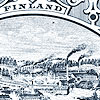

Contents 1/2002
Home



Häikiö, Martti
Nokia Oyj:n historia 1–3
[A history of Nokia plc 1–3]
Helsinki: Edita, 2001. 334p. + 326p. + 334p., ill.
ISBN 951-37-3467-6
€ 65 (US$ 57), paperback
(three volumes in a cardboard box)
I order a coffee and open my laptop, reach into
my pocket for my Nokia mobile phone and connect with the internet. The
infrared function opens up the connection and I read my e-mail. I browse
the net for a while, write a few messages and glance at the headlines
in the Helsingin Sanomat newspaper. Five minutes later I shut down
my computer, switch off my phone and look out of the window into a darkening
October evening in Manhattan. Downtown you can still sense the unpleasant
smell of the fallen World Trade Center towers.
I was in this same place ten years ago;
back then communications like these were merely the stuff of science-fiction.
I would call home from a land-line phone – but as a poor researcher
I could only afford reverse-charge calls. E-mail existed, but it was not
yet widely used. In those days the only people who carried – or dragged
– mobile phones around were yuppies and self-important businessmen.
Now Nokia's huge neon sign shines amidst
the advertising jungle on Times Square and its cellphones adorn the display
windows of every electronics shop. Parisians, Londoners and Berliners
also talk to each other through Nokia's mediation.
This aside, do people in general around the world know where Nokia is
from? In a globalised economy the presence of the world's leading companies
can be felt everywhere and yet they have no homeland, no history or national
ties. Their respective values are determined daily on the stock exchanges
of New York and London. Global enterprises are at work and making profit
24 hours a day in every time zone.
In Finland, Nokia is by far the largest
corporation in the country and the flagship of the economy. The value
of its shares accounts for over half of the Helsinki stock exchange, and
thus any rise and fall in the company sways the economy. Nokia's research
departments, factories and offices have sprung up in different parts of
the country and where Nokia decides to establish itself, that place seems
to become automatically blessed with affluence and prosperity.
Finns have a very sentimental view of Nokia.
Its reputation and honour are guarded like a national treasure. I even
notice myself secretly checking out the choice of mobile phone made by
other people in the café. Do they have a Nokia model or an American
Motorola? Amongst them might even be a few Swedish Ericssons in their
brightly coloured cases.
Ten years ago Finland had sunk into the
deepest financial depression in its history. The Soviet Union had broken
up and Europe was moving at full speed towards federation; trade with
the east, which for so long had supported Finland, crashed and currency-stabilising
loans lapsed. Nokia also fell into a struggle with death: the company
had skyrocketed during the 1980s from little Finland into the European
electronics markets under the guidance of its charismatic managing director
Kari Kairamo. Nokia's young engineers were energetic and inventive. Computers,
television sets and mobile phones were being sold all over the world,
and within Nokia there was always talk of ongoing training, innovation,
corporate strategies and market shares. Finland was rapidly becoming a
prosperous nation at the peak of technology. Kari Kairamo marketed Nokia's
shares with the simple slogan that could be translated as 'Grab a piece
of Europe'.
Finns wanted to leave behind them the stuffy
Russianness, Stalinism and the all-consuming party politics of the 1960s
and 70s. Young people were getting to know Europe on Interrail tickets;
ten years later this same generation would be buying millions of mobile
phones, internet connections and computers. The young marched over the
heads of the older generation into the era of communications, in which
mobile communication, rapid data-transfer and constant change were to
replace traditional tall factory chimneys and assembly lines.
The rise of Nokia was cut dramatically short
towards the end of the 1980s, when, instead of producing mass profits,
its huge investments in the European consumer electronics markets caused
enormous losses. The shareholders began to panic. Kari Kairamo felt that
he was being left alone and made his own solution in autumn 1988: the
burnt-out managing director took his own life.
Nokia had been set back on to square one.
Simo Vuorilehto, with a long career in the forest industry, was appointed
as the new managing director. Over a century of history came to an end
when the water power of the Nokia rapids – the company takes its
name from its home town in Southern Finland – was sold off. The same
happened to Nokia Data, which had been responsible for shaping Nokia's
image. The company tried to sell off consumer electronics, reaping terrible
losses, but no one wanted to invest in an industry which had long since
been pronounced dead. Nokia was severely overhauled; everything which
was not needed was dispensed with. The largest enterprise in Finland was
now to be sold off entirely to both east and west. The Dutch company Philips
expressed an interest in the possibility, but long negotiations over an
agreement eventually broke down. Neither was Nokia good enough for the
Swedish company Ericsson.
Luckily, the deal was off: Nokia found a
precious lifeline, along which it clambered back towards the future. One
of the departments of the old Helsinki Cable factory had in the 1960s
been renamed 'the cancer ward': all Nokia's research and development of
new products was concentrated here. The name was a crude way of describing
the losses which the electronics production and research had brought about
for the company. However, despite these financial losses, Nokia had acquired
ability, skills and self-confidence. The young and courageous Jorma Ollila
had been assigned the task of directing Nokia's mobile phone units. He
brought together the company's innovators, economic gurus and young talent,
and results gradually began to emerge.
Nokia developed new and competitive products;
its mobile phones were not just phones, but symbols of a new era. They
offered their owners social status, which included mobility, freedom and
continuous communication. Nokia was now marketing itself under the slogan
'Connecting People', an idea with which the interrailing generation of
the 1980s found it easy to identify – and Finns, who have often been
branded as 'silent types', all of a sudden had rather a lot to say to
each other on the train, in the car, in department stores, cafés
or restaurants. With a mobile phone people were constantly accessible.
People trained in mobile phone technology
were harnessed from universities and polytechnics. The high costs of research
and development programmes were covered by borrowing money and applying
for funding from the state. Nokia made itself an integral part of Finnish
high technology research units. The development of Oulu University, in
the north, would never have happened had it not been for Nokia. The same
can be said for Jyväskylä University and the technical high
schools in Otaniemi, Lappeenranta and Tampere. Nokia soon became the darling
of state-funded technology policies: the company has received continual
high levels of funding for research and development work carried out at
the National Technology Agency.
Nokia succeeded in resolving its crisis
at precisely the right moment. The governments of Europe had monopolies
over telecommunications and there was space on the free market for a few
aggressive operators. They offered their customers new services, the most
popular being the internet and mobile phones. Nokia was able to offer
these growing markets a device at the very peak of technology: the GSM
mobile phone. In a matter of a few years the Finnish electronics company
become one of the pillars of the global economy; it also sidelined both
its rivals Ericsson and Motorola.
Jorma Ollila's Nokia is fresh, fast, innovative, hard-working and global.
Humility and perseverance are qualities inherited from Nokia's history,
but the company does not bow before of the threats of the world's markets.
In its history spanning over a hundred years the company has been in terrible
difficulties on many occasions, but it has always managed to get through
one way or another. Ollila has created out of the multi-faceted enterprise
of the past a vast but well-trimmed electronics company.
This new Nokia is looking towards the future
without the burdens of the past; the task of writing its history is just
as daunting in size as the company itself. The collaboration between Martti
Häikiö and his co-writer Juhana Aunesluoma is an attempt to
document the history of Nokia from the 1860s to the present day. There
are in all three books, with the total number of pages approaching a thousand.
A fourth book is yet to appear: an abridged version of the whole project
in English.
The company started life during the 1860s
in the province of Häme, by the Nokia river, amidst great forests
and lakes, as a wood pulp and paper manufacturer. These products were
taken to Russia, where there were plenty of markets and ready cash. Soon
afterwards the family was joined by the Finnish Rubber Factory, producing
galoshes and rubber boots for the needs of the great neighbour to the
east. Later on, the Rubber Factory specialised in manufacturing bicycle
and car tyres. A third branch of the range of products came from the cable
industry. There was a market for this in Finland itself; being a geographically
vast country it needed an electricity and communications infrastructure.
As such, the Nokia of today was born of
forestry, electricity, cable and rubber manufacturers. Nokia's history
is full of people who were instrumental in shaping Finnish industry, of
whom a few names have disappeared into the mists of time. As Häikiö
and Aunesluoma describe Nokia's journey through the ages, they are also
describing Finland and the history of the Finns through the ravages of
time. They could have written even more about the past, but no doubt the
glitter of electronics has been difficult to resist.
I return once again to Manhattan: technology has done away with distance,
time and place. Terrorists make effective use of the instruments of modern
technology. Although many people may have planned to close off borders
in the light of the events of 11 September, in practice this remains impossible.
The world has opened up and it cannot be shut again without even more
horrific repercussions.
The story of Nokia is intrinsically linked
to the opening up of the world. Ten years ago Nokia was almost entirely
under Finnish ownership, today Finland owns but a few per cent. Its head
office is still in Finland and even the slightest suggestion of its moving
somewhere else would create the most almighty uproar. The success has
been astonishing, but Finns have nonetheless not become blind to the riches
this has brought about to surprisingly many Nokia executives; the new
stock option multimillionaires awaken envy and even disgust in Finns.
The nation wishes to see a Nokia which is humble, hard-working and grateful.
As such, it is still every Finn's own corporation.
Translated by David Hackston
![]()
Contents 1/2002 | Home